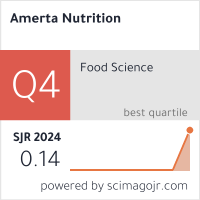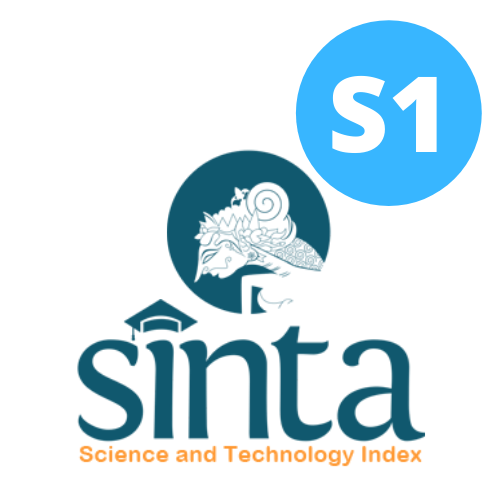Low Maternal Nutrition Knowledge and Insufficient Energy Intake in Toddlers as Risk Factors for Stunting in Agricultural Areas
Rendahnya Pengetahuan Gizi Ibu dan Defisiensi Asupan Energi Balita sebagai Faktor Risiko Stunting di Wilayah Pertanian

Downloads
Background: Stunting is a significant nutritional problem in Indonesia, with higher incidence rates compared to other nutritional problems. Its influencing factors include toddler’s nutritional intake, parenting practices, environmental health, access to health services, mother’s education, and family food security.
Objectives: This study sought to identify the most significant factors that contribute to the incidence of stunting in Sumowono District.
Methods: This quantitative case-control study compared mothers of stunted toddlers (ages 12–59 months) against those of normally developing toddlers. Participants were selected through purposive sampling. The risk factors for stunting examined in this study included mother’s knowledge, family food security, toddler’s nutritional intake, mother’s age, father’s occupation, family income, Direct Cash Assistance (BLT) recipient status, parenting practices, access to health services, and environmental health. Data were collected using questionnaire surveys, observations, and 24-hour recalls. Data analysis used bivariate (chi-square) and multivariate (logistic regression) methods.
Results: Most mothers of stunted toddlers had poor knowledge (81.1%) and lived in food-insecure families (86.5%). Bivariate tests showed associations between stunting and factors such as father’s occupation (p-value=0.019), family income (p-value=0.001), mother’s knowledge (p-value=0.001), family food security (p-value=0.001), energy intake (p-value=0.001), protein intake (p-value=0.001), vitamin A intake (p-value=0.036), vitamin D intake (p-value=0.027), zinc intake (p-value=0.036), parenting practices (p-value=0.011), and environmental health (p-value=0.001). The main factors found to influence stunting were mother’s knowledge (OR=19.144; CI: 1.919–190.953; p-value=0.012) and toddler’s energy intake (OR=227.996; CI: 16.899–3,076.100; p-value=0.001).
Conclusions: The incidence of stunting in Sumowono District was significantly influenced by mother’s knowledge and toddler’s energy intake.
Safitri, A. M., Pangestuti, D. R. & Aruben, R. Hubungan Ketahanan Pangan Keluarga dan Pola Konsumsi dengan Status Gizi Balita Keluarga Petani (Studi di Desa Jurug Kabupaten Boyolali Tahun 2017). J. Kesehat. Masy. 5, 120–128 (2017). DOI: https://doi.org/10.14710/jkm.v5i3.17181
Kementerian Kesehatan Republik Indonesia. Buku Saku Pemantauan Status Gizi ( PSG ) TAHUN 2017. (2018).
Yuliati, I. F. Segmentasi Wilayah Untuk Menekan Stunting Melalui Program 1000 Hari Pertama Kehidupan (Hpk). J. Kel. Berencana 5, 38–47 (2020).
Kemenkes. Hasil Survei Status Gizi Indonesia (SSGI) 2022. Kemenkes 1–150 (2022).
BPS Provinsi Jawa Tengah. Hasil Pencacahan Lengkap Sesus Pertanian 2023 - Tahap I Provinsi Jawa Tengah. (2023).
Ihza, S. E. F., Pangestuti, D. R., Asna, A. F. & Lisnawati, N. Status Gizi dan Perkembangan Motorik Balita Usia 24-59 Bulan di Wilayah Pertanian. Amerta Nutr. 8, 199–205 (2024). DOI: https://doi.org/10.20473/amnt.v8i2.2024.199-205
Hadijah, S. T. et al. Hubungan Daerah Tempat Tinggal dengan Status Gizi Anak di Kabupaten Bantaeng Periode Januari-Desember 2019. Med. J. J. Berk. Ilm. Kedokt. 5, 22–29 (2021). DOI: https://doi.org/10.26618/aimj.v5i1.7027
Ayu Saputri, U., Rahayuning Pangestuti, D. & Zen Rahfiludin, M. Pengetahuan Gizi dan Pola Asuh Ibu sebagai Faktor Risiko Stunting Usia 6-24 Bulan di Daerah Pertanian. Media Kesehat. Masy. Indones. 20, (2021). DOI: https://doi.org/10.14710/mkmi.20.6.433-442
Ramdhani, A., Handayani, H. & Setiawan, A. Hubungan Pengetahuan Ibu dengan Kejadian Stunting. in Semnas Lppm vol. V 28–35 (LPPM - Universitas Muhammadiyah Purwokerto, 2020).
Pragaye, H. N. Faktor-Faktor yang Mempengaruhi Kepatuhan Ibu Menyusui terhadap Pedoman Gizi Seimbang di Kecamatan Sumowono. (Universitas Diponegoro, 2023). Diakses melalui: https://eprints2.undip.ac.id/id/eprint/15245
Badan Pangan Nasional. FSVA Nasional Tahun 2023. (2023).
Saputro, W. A. & Fidayani, Y. Faktor-Faktor Yang Mempengaruhi Ketahanan Pangan Rumah Tangga Petani di Kabupaten Klaten. J. Agrica 13, 115–123 (2020). DOI:10.31289/agrica.v13i2.4078
Suryapramita Dusak, M. R., Sukmayani, Y., Apriliana Hardika, S. & Ariastuti, L. P. Gambaran Pengetahuan, Sikap, dan Praktik Ibu Balita terhadap Penatalaksanaan Diare pada Anak Balita di Wilayah Kerja Puskesmas Abang 1. Intisari Sains Medis 9, 85–94 (2018). DOI: 10.1556/ism.v9i2.168
Riawan, A. & Dewi, M. Hubungan antara Asupan Zat Gizi dengan Kadar Hemoglobin pada Anak Sekolah Dasar di Cijeruk , Bogor. 23, 84–90 (2023). DOI: 10.24815/jks.v23i1.27326
Dahlan, M. S. Statistik untuk Kedokteran dan Kesehatan. (2014).
Nurmalasari, Y. & Febriany, T. W. Hubungan Tingkat Pendidikan Ibu dan Pendapatan Keluarga dengan Kejadian Stunting pada Anak Usia 6-59 Bulan. J. Kebidanan 6, 205–211 (2020).
Amalia, I. D., Lubis, D. P. U. & Khoeriyah, S. M. Hubungan Pengetahuan Ibu Tentang Gizi Dengan Kejadian Stunting Pada Balita. J. Kesehat. Samodra Ilmu 12, 146–154 (2021). DOI: 10.55426/jksi.v12i2.153
Lolan, Y. P. & Sutriyawan, A. Pengetahuan Gizi dan Sikap Orang Tua Tentang Pola Asuh Makanan Bergizi dengan Kejadian Stunting. J. Nurs. Public Heal. 9, 116–124 (2021). DOI: https://doi.org/10.37676/jnph.v9i2.1815
Septriana, D. C. D. G. Ketahanan Pangan Tingkat Rumah Tangga, Asupan Protein Dan Kejadian Stunting Pada Anak Balita Di Desa Planjan Kecamatan Saptosari Gunung Kidul. Med. Respati J. Ilm. Kesehat. 14, 78 (2019). DOI: https://doi.org/10.35842/mr.v14i1.212
Ayuningtyas, A., Simbolon, D. & Rizal, A. Asupan Zat Gizi Makro dan Mikro terhadap Kejadian Stunting pada Balita. J. Kesehat. 9, 445 (2018). DOI: 10.26630/jk.v9i3.960
Aisyah, I. S. & Yunianto, A. E. Hubungan Asupan Energi Dan Asupan Protein Dengan Kejadian Stunting Pada Balita (24-59 Bulan) Di Kelurahan Karanganyar Kecamatan Kawalu Kota Tasikmalaya. J. Kesehat. Komunitas Indones. 17, 240–246 (2021). DOI: https://doi.org/10.37058/jkki.v17i1.360
Kundarwati, R. A., Dewi, A. P. & Wati, D. A. Hubungan Asupan Protein, Vitamin A, Zink, dan Fe dengan Kejadian Stunting Usia 1-3 Tahun. J. Gizi 11, 9–15 (2022).
van Stuijvenberg, M. E. et al. Low Intake of Calcium and Vitamin D, but not Zinc, Iron or Vitamin A, is associated with stunting in 2- to 5-year-old children. Nutrition 31, (2015). DOI: https://doi.org/10.1016/j.nut.2014.12.011
Marsellinda, E. & Ferilda, S. Analisis Tingkat Asupan Kalsium Dan Vitamin D Terhadap Kejadian Stunting Pada Balita Di Sijunjung. J. Buana Farma 3, 99–104 (2023). DOI: https://doi.org/10.48191/medfarm.v12i2.240
Rahmadani, N. A., Bahar, B. & Dachlan, D. M. Hubungan Asupan Zat Gizi Makro Dan Zat Gizi Mikro Dengan Stunting Pada Anak Usia 24-59 Bulan Di Wilayah Kerja 1 Puskesmas Kabere Kecamatan Cendana Kabupaten Enrekang. J. Gizi Masy. Indones. J. Indones. Community Nutr. 8, 90–97 (2019). DOI: https://doi.org/10.30597/jgmi.v8i2.8512
Zen Rahfiludin, M., Aruben, R., Gizi Kesehatan Masyarakat, B., Kesehatan Masyarakat Universitas Diponegoro, F. & Kesehatan, F. Faktor Risiko Kejadian Stunting pada Anak Balita Usia 24-59 Bulan (Studi Kasus di Wilayah Kerja Puskesmas Gabus II Kabupaten Pati Tahun 2017). J. Kesehat. Masy. 6, 2356–3346 (2018). DOI: https://doi.org/10.14710/jkm.v6i1.19900
Fujica Wati, I. et al. Pola Asuh Orang Tua terhadap Kejadian Stunting pada Balita Usia 24-59 Bulan. Wellness Heal. Mag. 3, 103–107 (2021). DOI: 10.30604/well.292622024
Yudianti, Y. & Saeni, R. H. Pola Asuh dengan Kejadian Stunting pada Balita di Kabupaten Polewali Mandar. J. Kesehat. Manarang 2, 21 (2017). DOI: https://doi.org/10.33490/jkm.v2i1.9
Noorhasanah, E. & Tauhidah, N.I. Hubungan Pola Asuh Ibu dengan Kejadian Stunting Anak Usia 12-59 Bulan. J. Ilmu Keperawatan Anak 4, 37–42 (2021). DOI: https://doi.org/10.32584/jika.v4i1.959
Rahmayana, A. Ibrahim, I. & Santy Damayanti, D. Hubungan Pola Asuh Ibu dengan Kejadian Stunting Anak Usia 24-59 Bulan di Posyandu Asoka II Wilayah Pesisir Kelurahan Barombong Kecamatan Tamalate Kota Makassar tahun 2014. Al-Sihah Public Heal. Sci. J. 6, 424–436 (2014). DOI: https://doi.org/10.24252/as.v6i2.1965
Ahmed, N., Barnett, I. & Longhurst, R. Determinants of Child Undernutrition in Bangladesh Literature Review. Mqsun 30 (2015).
Apriluana, G. & Fikawati, S. Analisis Faktor-Faktor Risiko terhadap Kejadian Stunting pada Balita (0-59 Bulan) di Negara Berkembang dan Asia Tenggara. Media Penelit. dan Pengemb. Kesehat. 28, 247–256 (2018). DOI: https://doi.org/10.22435/mpk.v28i4.472
Purnama, Y., Hikmah, E. N., Kebidanan, A. & Bunda, H. Hubungan Pola Tidur dengan Kejadian Stunting pada Balita Usia 24-60 Bulan di Kelurahan Kendo Wilayah Kerja Puskesmas Penanae Kota Bima Tahun 2024. J. Kesehat. Masy. Bidan 10, 10–15 (2024). Diakses melalui https://jurnal.harbundbima.ac.id/index.php/jkm-bid/article/view/3
Rosalina, M., Novayelinda, R. & Lestari, W. Gambaran Kualitas Tidur Bayi Usia 6-12 Bulan. J. Med. Hutama 3, 2956–2965 (2022).
Romanos-Nanclares, A. et al. Influence of parental healthy-eating attitudes and nutritional knowledge on nutritional adequacy and diet quality among preschoolers: The SENDO project. Nutrients 10, (2018). DOI: https://doi.org/10.3390/nu10121875
Juliarti, W. & Megasari, K. Mother ’ s Knowledge of Stunting in Toddlers at the Arrabih Pratama Clinic , Pekanbaru. J. Midwifery Nurs. 3, 59–62 (2021). Diakses melalui https://iocscience.org/ejournal/index.php/JMN/article/view/1159
Aritonang, E. A., Margawati, A. & Dieny, F. F. Analisis Pengeluaran Pangan, Ketahanan Pangan Dan Asupan Zat Gizi Anak Bawah Dua Tahun (Baduta) Sebagai Faktor Risiko Stunting. J. Nutr. Coll. 9, 71–80 (2020). DOI: https://doi.org/10.14710/jnc.v9i1.26584
Kurniasari, N., Permatasari, T. A. E. & Yudistria, S. Kebiasaan Konsumsi Susu Kental Manis (SKM), Krimer Kental Manis (KKM) dan Status Gizi Balita di Provinsi Kalimantan Tengah, Aceh dan Sulawesi Utara. J. Pendidik. dan Konseling 4, 4652–4658 (2022). DOI: https://doi.org/10.31004/jpdk.v4i4.6202
Harlan, J. Analisis Regresi Terapan Edisi ke-2. (Gunadarma, 2018).
Copyright (c) 2025 Amerta Nutrition

This work is licensed under a Creative Commons Attribution-ShareAlike 4.0 International License.
AMERTA NUTR by Unair is licensed under a Creative Commons Attribution-ShareAlike 4.0 International License.
1. The journal allows the author to hold the copyright of the article without restrictions.
2. The journal allows the author(s) to retain publishing rights without restrictions
3. The legal formal aspect of journal publication accessibility refers to Creative Commons Attribution Share-Alike (CC BY-SA).
4. The Creative Commons Attribution Share-Alike (CC BY-SA) license allows re-distribution and re-use of a licensed work on the conditions that the creator is appropriately credited and that any derivative work is made available under "the same, similar or a compatible license”. Other than the conditions mentioned above, the editorial board is not responsible for copyright violation.












































